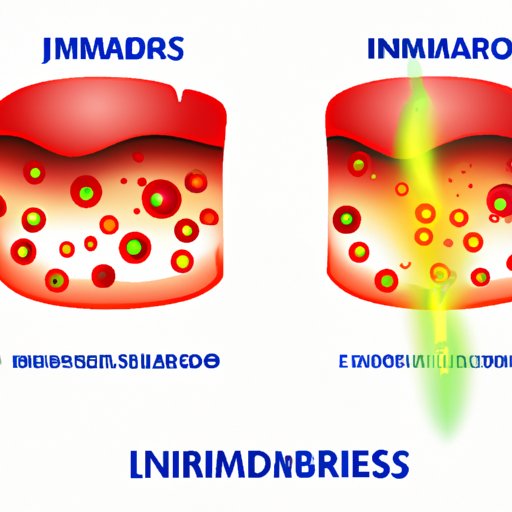
Introduction
Inflammatory disease affects millions of people worldwide and can have a significant impact on their daily lives. This type of condition can range from mild to severe and can affect any part of the body. Understanding what inflammatory diseases are and how they can be prevented and treated is crucial to better health and wellbeing.
A. What is Inflammatory Disease?
Inflammatory diseases refer to a group of conditions that are caused by inflammation in the body. When inflammation occurs, the body’s immune system sends out an army of cells to attack the perceived threat, which can cause redness, swelling, pain, and heat in the affected area.
B. Importance of Understanding Inflammatory Disease
It is important to understand inflammatory disease because these conditions can cause significant discomfort and can lead to severe complications and chronic illness if left untreated. By understanding what causes inflammation, how it affects the body, and how it leads to disease, we can take steps to prevent and manage inflammatory conditions.
II. The Root Cause of Inflammatory Disease: Understanding the Basics
A. Definition and Explanation of Inflammation
Inflammation is a natural response of the immune system to injury or infection. It is designed to protect the body by destroying or deactivating harmful agents and initiating the healing process. Inflammation can be acute or chronic, and chronic inflammation can lead to a range of diseases.
B. Causes of Inflammation
Inflammation can be triggered by a wide range of factors, including infection, injury, and exposure to toxins or allergens. Some chronic diseases, such as diabetes and autoimmune disorders, can also contribute to ongoing inflammation.
C. How Chronic Inflammation Develops
Chronic inflammation develops when the immune response becomes overactive and does not turn off as it should. This can lead to ongoing damage to healthy tissues and organs and can contribute to the development of various inflammatory conditions.
III. How Inflammation Causes Disease: A Comprehensive Guide
A. Understanding the Immune System
The immune system is a complex network of cells, tissues, and organs that work together to fight infection and protect against disease. When a threat is detected, the immune system sends out white blood cells to destroy the threat and initiate healing.
B. The Inflammatory Response and Its Consequences
During the inflammatory response, immune cells release chemicals that increase blood flow to the affected area and bring white blood cells to the site of injury. This process can cause redness, swelling, and pain.
If the inflammatory response is not resolved, it can lead to ongoing damage to healthy tissues and organs. Chronic inflammation has been linked to a range of diseases, including obesity, diabetes, and cardiovascular disease.
C. Chronic Inflammation and Its Effects on the Body
Chronic inflammation can lead to a range of health problems, including:
- Joint pain and stiffness
- Chronic fatigue
- Digestive problems
- Increased risk of heart disease
- Depression and anxiety
- Increased risk of certain types of cancer
IV. Exploring the Link Between Inflammation and Common Diseases
A. Cardiovascular Disease
Chronic inflammation plays a significant role in the development of cardiovascular disease. Ongoing inflammation can damage blood vessels, leading to a buildup of plaque and an increased risk of heart attack and stroke.
B. Diabetes
Diabetes is a chronic illness that is characterized by high levels of glucose in the blood. Chronic inflammation can contribute to insulin resistance, which can lead to the development of type 2 diabetes.
C. Cancer
Chronic inflammation has been linked to an increased risk of certain types of cancer, including colon, liver, and lung cancer. Ongoing inflammation can damage DNA and contribute to the development of cancer cells.
D. Neurological Diseases
Researchers have found a link between chronic inflammation and a range of neurological diseases, including Alzheimer’s disease, Parkinson’s disease, and multiple sclerosis. Ongoing inflammation in the brain can lead to the death of brain cells and contribute to the development of these conditions.
V. Beyond Pain and Swelling: What You Need to Know About Inflammatory Diseases
A. Symptoms of Inflammatory Diseases
Symptoms of inflammatory diseases can vary depending on the condition and the affected area of the body. Common symptoms may include:
- Pain and stiffness
- Swelling and redness
- Fatigue
- Fever
- Weight loss
- Muscle weakness
B. Impact on Daily Life
Inflammatory diseases can have a significant impact on a person’s daily life, limiting their ability to perform tasks and engage in activities they enjoy. Chronic pain, fatigue, and mobility issues can significantly reduce quality of life and cause mental health problems such as anxiety and depression.
C. Complications and Risks
If left untreated, inflammatory diseases can lead to serious complications, including organ damage and failure. Some conditions, such as rheumatoid arthritis, can also increase the risk of infections and other health problems.

VI. Inflammatory Diseases Demystified: Debunking Common Misconceptions
A. Misconceptions about Inflammatory Diseases
There are several misconceptions about inflammatory diseases, including the belief that they only affect older adults and that they are always caused by physical injury. In reality, inflammatory diseases can affect people of all ages and can have a range of causes.
B. Causes of Misconceptions
Misconceptions about inflammatory diseases can be caused by a lack of understanding and education about these conditions. The media can also contribute to misconceptions by oversimplifying complex issues and focusing on extreme cases rather than typical experiences.
C. Education as a Tool to Fight Misconceptions
Education is a powerful tool to fight misconceptions about inflammatory diseases. By providing accurate information about the causes, symptoms, and treatments of these conditions, we can help reduce stigma and improve outcomes for those living with inflammatory diseases.
VII. Preventing Inflammatory Diseases: Lifestyle Changes to Consider
A. Diet and Nutrition
A healthy diet that is rich in fruits, vegetables, whole grains, and lean protein can help reduce inflammation in the body. Foods high in sugar, saturated fat, and processed ingredients should be avoided.
B. Exercise and Physical Activity
Regular exercise can help reduce inflammation in the body and improve overall health and wellbeing. Aim for at least 30 minutes of moderate-intensity exercise per day, such as brisk walking, cycling, or swimming.
C. Sleep and Rest
Adequate sleep and rest are essential for overall health and can help reduce inflammation in the body.
D. Stress Management
Effective stress management techniques, such as meditation, yoga, and deep breathing exercises, can help reduce inflammation in the body and improve overall wellbeing.
E. Avoiding Triggers
If you have a known inflammatory condition, it is essential to identify and avoid triggers that can exacerbate symptoms. These triggers may include certain foods, stress, and exposure to allergens or toxins.
VIII. From Arthritis to Crohn’s: A Closer Look at Different Types of Inflammatory Diseases
A. Arthritis and Joint Inflammation
Arthritis refers to a group of conditions that cause inflammation in the joints. Osteoarthritis is the most common type of arthritis and is caused by wear and tear on the joints over time. Rheumatoid arthritis is an autoimmune condition that causes inflammation in the joints and can lead to joint damage and disability.
B. Skin Inflammation and Psoriasis
Psoriasis is a chronic autoimmune condition that causes inflammation and skin cell overgrowth, leading to thick, scaly patches on the skin. Psoriasis can cause significant discomfort and can lead to complications such as joint damage and depression.
C. Bowel Inflammation and Crohn’s Disease
Crohn’s disease is a chronic inflammatory condition that affects the digestive tract, leading to symptoms such as abdominal pain, diarrhea, and weight loss. Crohn’s disease can cause significant damage and scarring of the digestive tract and increase the risk of complications such as infections and bowel obstructions.
IX. Conclusion
A. Recap of Key Points
Inflammatory diseases are conditions caused by inflammation in the body. Chronic inflammation can lead to a range of health problems, including cardiovascular disease, diabetes, cancer, and neurological diseases. Prevention and treatment of these conditions involve lifestyle changes, including diet, exercise, stress management, and avoiding triggers.
B. Call to Action
If you are experiencing symptoms of an inflammatory disease, seek medical attention for a proper diagnosis and treatment plan. Educate yourself and others about the causes and consequences of inflammatory diseases to help reduce stigma and improve outcomes for those living with these conditions.
C. Final Thoughts
Inflammatory diseases can affect people from all walks of life and can have a significant impact on their overall health and wellbeing. By understanding the root causes of inflammation and taking steps to prevent and manage inflammatory conditions, we can improve our health and quality of life.




